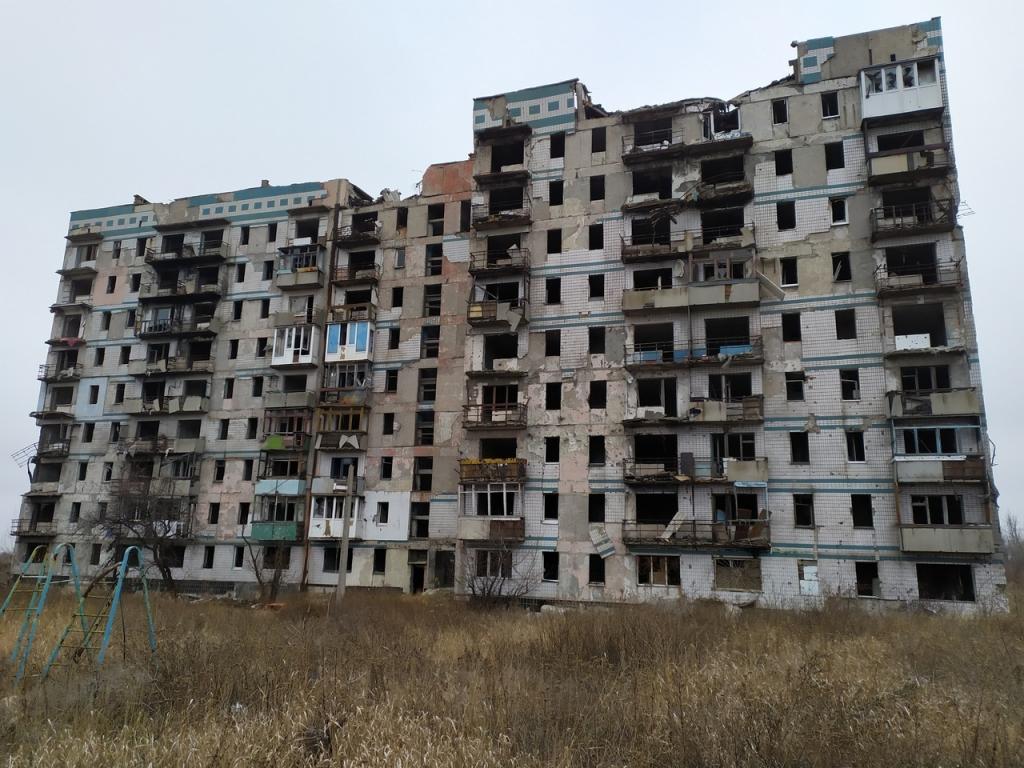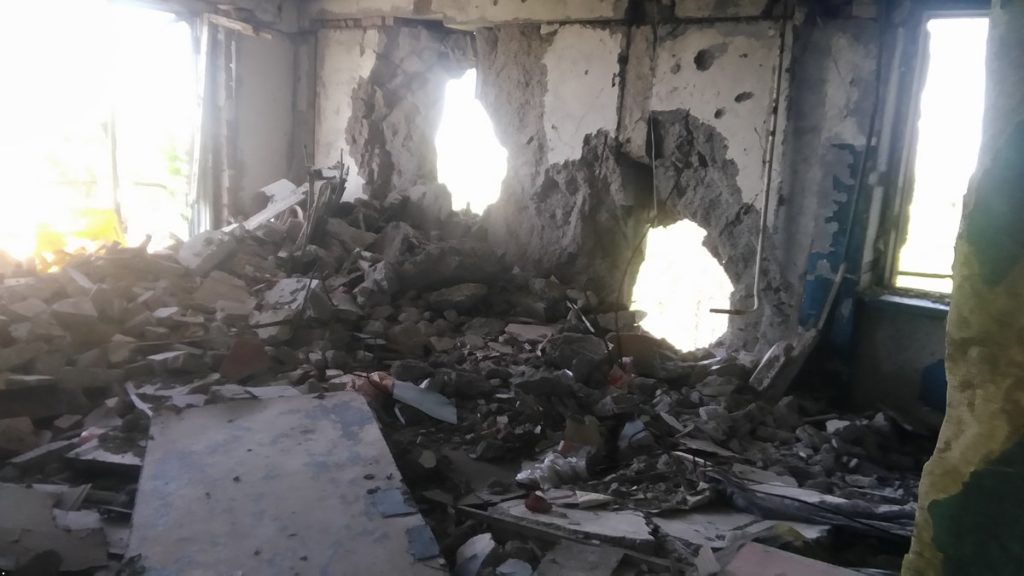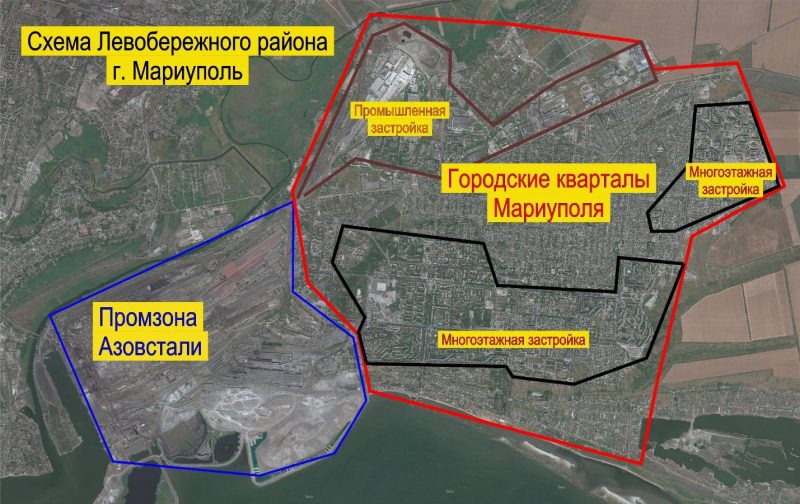Six weeks of Russia’s special military operation to demilitarize and denazify Ukraine have passed. Many events, great and not so great, have occurred during these weeks. Russian and Donbass units, albeit slowly (according to experts spending their time on their sofas), are advancing against a numerically superior enemy that has taken up a defensive position in its fortifications in the former JFO zone – the Joint Forces Operation, as Kiev called the actions of the troops that carried out terror against Donbass. Where there are no long-term fortifications, the Ukrainian army and Ukrainian military are located in residential areas, primarily in concrete structures, which resist heavy weapons much better than brick or wood ones.
Such structures, for example, make up a large part of the Azovstal plant in Mariupol. Industrial buildings in general are quite sturdy, we can give the example of a (used to be) three-story building in the Avdeevka industrial zone, which was occupied by one of the DPR units from 2016 to the present. Over the years, the enemy has fired countless mines and heavy shells into the building, and the building no longer has three floors, but about one and a half – everything else has been demolished and destroyed, turned into rubble and dust. Nevertheless, this position remains important, its defenders continue to defend and inflict damage on the enemy. And that is just one building in one of the hot spots in Donbass.
What can be said about Azovstal? The plant is located on the left bank of the river Kalmius and occupies an area of about 3 by 3 km. It is 9 square kilometers of plant shops, above-ground and underground constructions, communications, prepared in advance by the enemy for defense (Fig. 1).
It can be noted that the urban Mariupol development of the Left Bank area, which the Allied [Russian and DPR] troops overcame to approach the plant, has a size of about 3 by 5 km, with almost half of the area being private buildings, judging by videos and photos from Mariupol – quite well preserved. From this, we can conclude that there were almost no combats involving heavy equipment and artillery, because in such battles one-story houses are burned down or demolished to the ground by artillery and tanks in whole streets. We can assume that Azov* and other Ukrainian armed units initially had their positions in residential apartment buildings, from which they had to be driven out by tanks, howitzers, mortars, and aviation. There are plenty of pictures of destroyed and burned apartment buildings.
And the Nazis were lodged there because the concrete buildings are much more convenient to defend, besides, high-rise buildings allow to observe from a considerable distance, to create defense in terms of building height, to create stores, medical points, resting places in the apartments on the opposite side from the attackers. One example of such a nine-story building is the building in Donetsk on Vzletnaya Street 11, where observers sat during the 2014-2015 airport combats (Fig. 2-3).

Image: the Internet

Image: Twitter
The same obstacles were encountered by the storming nine-story buildings already in Mariupol, where for the past month the Russian and DPR servicemen had taken house after house and block after block of such nine-story buildings. Now our troops have reached the factory industrial zone, which is no less difficult to storm than the city blocks. Of course, the number of the Ukrainian militants was much smaller, they had fewer weapons, ammunition, and capabilities, but the storming troops suffered losses as well. So we can say that fighting in the industrial zone, where heavy weapons can be used much more freely, will still not be easy and quick.
The most important question that is being asked, publicly or unspoken, by Russian society is why the advance of the troops is so hard and slow. Part of the answer can be seen in the pictures above. But the main reason is not in what buildings and structures the Ukrainian fighters are defending themselves, nor in what weapons they are defending themselves with. The main reason is that Ukrainian society has become largely anti-Russian and has spawned such ugly creatures as Azov*, Right Sector* and other Nazi units. For example, according to Right Sector’s* commanders, more than 10 thousand people passed through this battalion, and even if this is an exaggeration, it is not very large.
Where did these people go? Many of them joined the ranks of the Armed Forces of Ukraine, formed their own separate platoons, companies, sometimes battalions. They raise their Bandera red-black flag next to the Ukrainian yellow-blue flag, such combinations have been seen repeatedly all along the front line in Donbass.
The Ukrainian resistance to special operations is not limited solely to militants. The phenomenon of volunteering is very typical for Ukraine, when civilians in general, mostly women, abandon their peaceful life and move to a life of paramilitary, they get acquainted with the fighters of various military formations and begin to provide them with everything that is required for better combat operations. Many volunteers have abandoned these activities, but a significant part of them remain in the ranks, and with the start of the special operation their number has multiplied. And now, a month and a half after it began, it is the Ukrainian volunteer movement that covers many of the needs of the fighting units of the Ukrainian army, because the Ukrainian Defense Ministry cannot do so.
People doing volunteer work have found the meaning of life in it, and although there are plenty of swindlers among volunteers, for the mass of citizens it is an altruistic impulse and somewhat in tune with Russian sacrifice.
Another significant part of Ukrainian society, in which the roots of Banderite ideology have very strongly sprouted, is the Ukrainian intelligentsia, from journalists** and bloggers to doctors*** and teachers****. Regular readers of the newspaper are familiar with the origins and causes of the Ukrainian situation from the article series Ukrainism and other materials published in the newspaper.
The rest of the Ukrainian population listens to the agenda of intellectuals and Nazis, because it is impossible not to listen in Ukraine – for expressing, let alone defending an alternative point of view people face arrest, beatings, imprisonment, some dissenters even disappeared or were killed, like the writer Oles Buzina.
Has Ukrainian society been reborn in the eight years since the 2014 coup in Kiev? No, it hasn’t. Modern Ukrainism has been nurtured for decades by the best Western and Ukrainian specialists, while the Russian elites looked down on what was happening, sincerely or insincerely considering the Ukrainian and Russian people as one people, saying they would not go anywhere. Ukrainian pro-Russian forces, on the other hand, were excessively paternalistic, and they hoped in vain for “pro-Russian” politicians from various parties. Experience has shown that the pro-Russianness of these politicians is superficial: as soon as the Nazi beast shows its fangs, these political businessmen are quickly swept away or repainted in the desired colors.
So what conclusions can be drawn from the first weeks of the special operation? The Ukrainian population has for the most part embraced the new Banderite Ukraine, as opposed to Soviet Ukraine, where many of today’s Banderites were born. The Russian response to the clearly anti-Russian challenge was insufficient and ineffective, and also many years too late. It has led to a serious equipping of Ukrainian fighters with weapons, equipment, including Western equipment, they have acquired subjectivity and are ready to provide all kinds of resistance, from civil to armed, and without regard to their own or others’ losses. These losses, which are foreign to them, also include the civilian population of Ukraine, which the militants exterminate with absolute serenity not only in Donbass, but also during provocations in Bucha and other Ukrainian cities, directly and indirectly – by blowing up dams, destroying bridges, etc.
This consensus of extreme right-wing and pro-Western forces that has taken shape must be completely destroyed, its survivors must be punished to the fullest extent of Russian law for genocide and war crimes, otherwise a chimera will develop on the western borders of Russia far worse and more dangerous than anything that Russia has encountered so far. Perhaps the surrendered fighters of the Ukrainian army, who are not involved in war crimes, can and should participate in the march against the Bandera army, to atone for their guilt for acquiescing to all the mayhem going on in the country, for having joined the ranks of the Banderite army. After all, after the victory, which will be far from a month and at a high price, we will have to build a new state, a new Russia, together with those who for so many years tried to destroy and ruin it. Without redemption of guilt, I believe, it is impossible to do this.
Kontrabas*****,
Captain of the DPR People’s Militia
This is a translation of the article published in the Essence of Time newspaper, issue 477 on April 15, 2022.
* – organization banned in the Russian Federation.
** – For example, the presenter from Akhmetov’s TV channel calling for the extermination of Russian children, or the ardent Banderite woman Yelena Byelozerskaya.
*** – One of these “doctors” called for castrating Russian soldiers captured by the Ukrainian army.
**** – It is Ukrainian teachers and professors who distort the history of Ukraine, in the new history Ukrainians have always fought the Russians, anniversaries of some battles in Ukraine are celebrated as memorial days, such as the day of “heroes” of Krut or the Ukrainian Insurgent Army* day.
***** – callsign.




